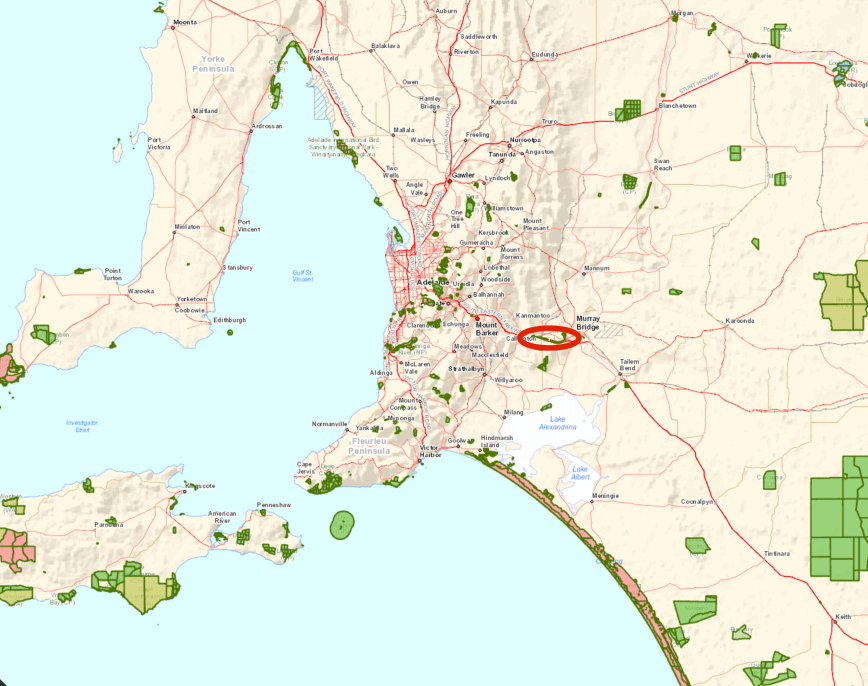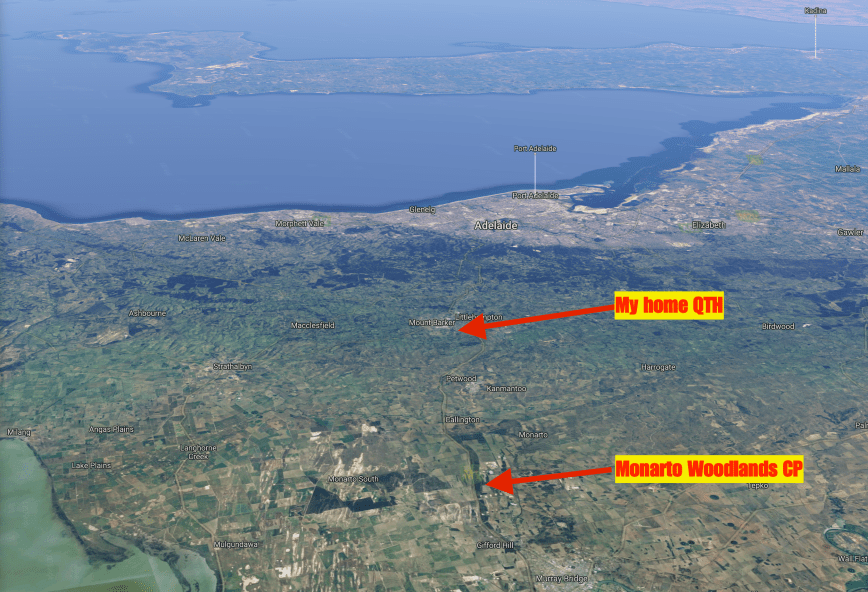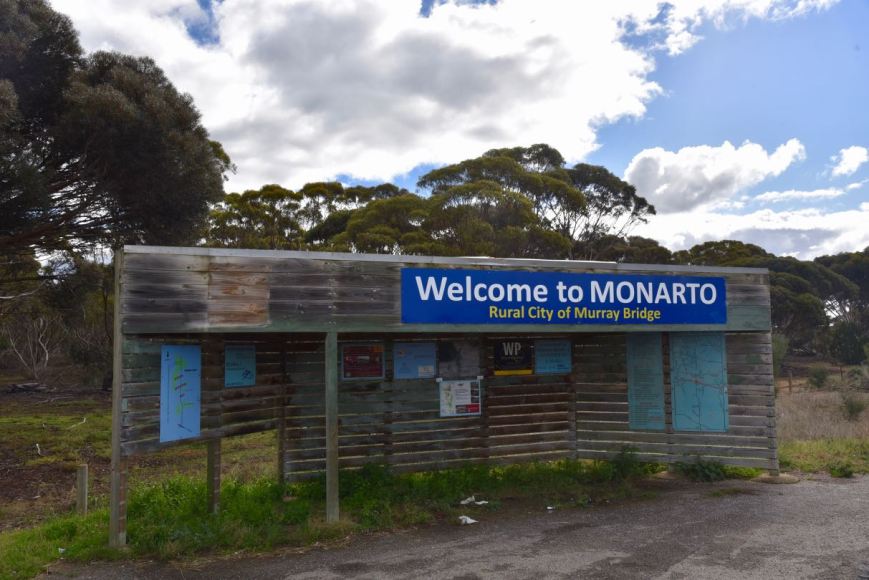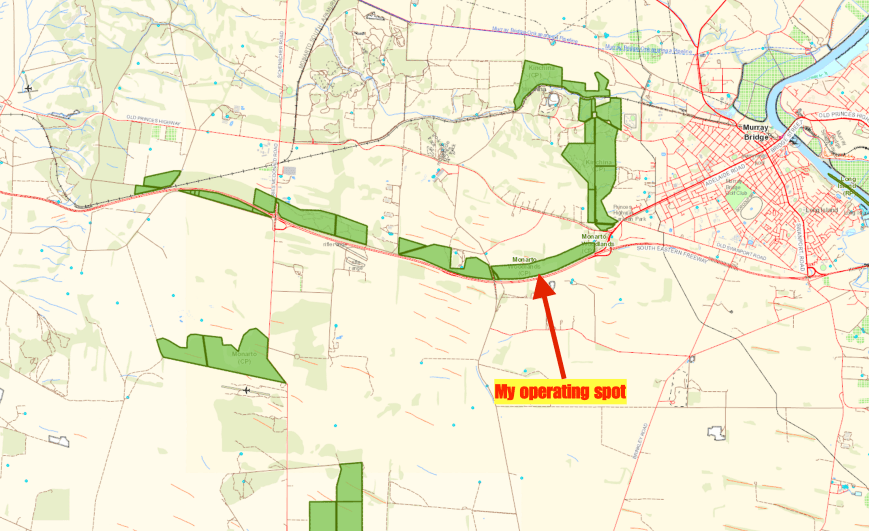Over the weekend just gone I spent most of my weekend off in front of the computer, comparing CAPAD data with existing parks for the World Wide Flora Fauna (WWFF) program. By Sunday (9th July 2017) luncthime I had became totally annoyed with being glued to the computer, so I decided to brave the cold weather and head out to activate a park. That day I had officially released the VKFF Boomerang Award for the WWFF program, rewarding activators who activate the same park on multiple occasions. So I decided to head just up the road and activate the Monarto Woodlands Conservation Park 5CP-276 & VKFF-1763. The park is located about 60 km east of Adelaide.

Above:- Map showing the location of the Monarto Woodlands Conservation Park, east of Adelaide. Map courtesy of Location SA Map Viewer.
The Monarto Woodlands Conservation Park is a new park and was only gazetted on the 22nd September 2016. It was previously set aside as Crown land. The park extends about 15 km along the South Eastern Freeway from near Callington to Murray Bridge. The park is 426 hectares in size, and provides important habitat for more than 60 bird species, five of which are of State conservation significance.

Above:- Aerial shot showing the park in relation to my home QTH. The city of Adelaide and the Gulf ST Vincent and the Yorke Peninsula can be seen in the background. Image courtesy of Google Maps
The scrub located within the park is a mixture of plant species from across Australia. This is due to the extensive planting in the area due to the proposed satellite city of Monarto back in the 1970’s. The then South Australian Premier, Don Dunstan had proposed that Monarto, or ‘New Murray Town’ would become the site of a satellite city of Adelaide. However this concept was eventually abandoned. Today, Monarto is little more than a railway siding. The Monarto open plains zoo is also located nearby.

I headed to my normal operating spot in the park. Access is via White Road.

Above:- Map of the park showing my operating spot. Map courtesy of Location SA Map Viewer.
There is a track which leads into the park. I found a nice cleared area in amongst the scrub,and set up my station comprising the Yaesu FT-857d and the 80/40/20m linked dipole. It was initially not a very pleasant day, very overcast and quite cold, with the occasional sprinkle of rain. But as this was a Conservation Park I wanted to operate independent of the vehicle as is required in the rules for the VK5 National & Conservation Parks Award. So I put the bothy bag to good use during this activation, with periods of operation from underneath it when it started to rain.
After setting up I headed to 7.144 and heard Neil VK4HNS working Rob VK4AAC who was activating a park. But sadly, Rob’s signal was so low that I decided it just wasn’t worth calling him. Feeling rather dejected because I had missed out on the Park to Park contact, I headed down the band to 7.139 and started calling CQ. Kev VK3VEK from western Victoria was number one in the log. This was followed by regular park hunters Mick VK3GGG/VK3PMG, Peter VK3PF, Ken VK2KYO, and then my good wife Marija VK5FMAZ.
Much to my surprise, contact number 9 was with Rob VK4AAC/p whose signal had come up to a very readable 5/3. From my home QTH I would not have been able to work Rob, but as there was no man made noise on the band due to my location, I was able to hear Rob very well from the Freshwater National Park VKFF-0187.
Contact number 21 was another Park to Park, this time with Mark VK4SMA/p who was in the Dwyers Scrub Conservation Park VKFF-1534. This was a first time activation of the park, so it was a pleasure to be able to log Mark. Mike VK5MCB then called in from Farina, a ghost town in the Far North of South Australia. I visited Farina a few years ago with Marija and a few other amateurs, and operated as VK100ANZAC.
The 40m band was in average-good condition, with quite a bit of QSB on the signals. However I was very happy to have a constant stream of callers. Contact number 39 was another Park to Park, with Gerard VK2JNG/p who was activating the Durridgere Coordinated Conservation Area. I logged a total of 46 stations before callers ceased. I took the opportunity of heading down the band to 7.087. Marija had sent me a text to advise that Ian VK5MA/6 was in a park in Western Australia. I logged Ian who was in the Stirling Range National Park VKFF-0467, with a good 5/7 signal.
As it was the weekend for the IARU HF championships, I heard quite a few good signals coming in on 40m from Europe. But sadly the few stations I called were unable to hear my 40w signal. So I decided to try my luck on 20m.
Prior to calling CQ I had a tune around the band to see what conditions were like. I heard a few European stations but they were not very strong. But the North American stations were strong. I logged Greg NR6Q in California USA, and then 9A0HQ in Croatia. I then propped on 14.310 and prior to calling CQ I decided to place a post on the KFF Facebook page stating I was portable and looking for North American contacts. Soon after I had my first USA station in the log, Jeremy in Colorado. Hans VK6XN/p then called in, maritime mobile off the coast of Freemantle, running a Buddipole. Hans had a good 5/7 signal. My first maritime mobile contact whilst mobile…thanks Hans.
I was then called by Conny N5HC, Lee VK2LEE, and then Rob VK4AAC/p in VKFF-0187. I was pleasantly surprised to then get a string of DX callers from USA, Costa Rica, New Zealand, Canada, Japan, and Alaska. Amongst the DX I also logged a few more VK’s including Stuie VK8NSB in Darwin. Unfortunately the DX dried up quite quickly, so I tuned across the 20m band and logged a further 10 stations from USA, Czech Republic, Mexico, Germany, and the Canary Islands.
I then headed back to 40m where I logged a further 17 stations from VK2, VK3, VK4, VK5, VK6 and New Zealand. This included Jim VK5JW who was operating portable from a sheep station near Lake Eyre in the Far North of VK5. The band was becoming very busy and I was competing with a YV5 station ont he frequency from Venezuela, so I QSY’d to 7.152 where I logged another 3 VK’s, before heading off to the 80m band.
I called CQ on 3.610 and this was answered by Adam VK2YK, followed by Lou VK3ALB, and then Joe VK3MAB. Conditions on 80m were excellent, with a total of 14 stations logged from VK1, VK2, VK3, and VK5.
I had now surpassed 100 contacts for the activation. I decided to have one last quick listen on 40m hoping to log some North American stations. However, the few that I did call, could not hear me. I did however, log ZL6HQ and Warren ZL2AJ in New Zealand.
The temperature had dropped down to a very chilly 8 deg and it was about 5.30 p.m. local time, and time for me to pack up and head home. I was very happy, with a total of 114 QSO’s in the log, with some nice DX contacts.
I worked the following stations on 40m SSB:-
- VK3VEK
- VK3GGG
- VK3PMG
- VK3PF
- VK2KYO
- VK5FMAZ
- VK3ARH
- VK3KMH
- VK4AAC/p (Freshwater National Park VKFF-0187)
- VK3OHM
- VK2YK
- VK3ANL
- VK3NXT
- VK5NFT
- VK7QP
- VK3JP
- VK2PKT
- VK3PAT
- VK3BHR
- VK5KLV
- VK4SMA/p (Dwyers Scrub Conservation Park VKFF-1534)
- VK5MCB/p
- VK3QB
- VK3SQ
- VK3WAR
- VK1VIC/m
- VK7FGRA
- VK2HHA
- VK3VIN
- VK2LEE
- VK3GQ
- VK2NP
- VK3VLA
- VK2QK
- VK1AT
- VK3FTRI
- VK7FRJG
- VK5PET
- VK2JNG/p (Durridgere Co-ordinated Conservation Area VKFF-1314)
- VK3NBL
- VK4SOE/p
- VK2GKA
- VK3DBP
- VK4FW
- VK7AN
- VK2IO
- VK5MA/6 (Stirling Range National Park VKFF-0467)
- VK7DW
- VK3ZPF
- VK4FARR
- VK4KUS
- VK2VRC
- ZL1TM
- VK3AJA
- VK3BSG
- ZL2ASH
- VK3KTO
- VK2OA
- VK5JW/p
- VK3BBB
- VK6WC
- VK3CWF
- VK3MAB
- VK4QQ
- VK3ZVX
- VK3SX
- VK7JON
- ZL6HQ
- ZL2AJ
I worked the following stations on 20m SSB:-
- NR6Q
- 9A0HQ
- KE0HQO
- VK6XN/mm
- N5HC
- VK2LEE
- VK4AAC/p (Freshwater National Park VKFF-0187)
- AB5NX
- TI1K
- W6TXK
- N7VF
- ZL4KD
- VK8NSB
- K0BBC
- VE7CV
- JA8RJE
- N7GCO
- AL7KC
- VK4FW
- VK4FE
- VK2ZH
- K7GDL
- OL7HQ
- K4AB
- K3ZJ
- W5FMH
- KU2M
- AB4EJ
- XE1LM
- DA0HQ
- EF8R
I worked the following stations on 80m SSB:-
- VK2YK
- VK3ALB
- VK3MAB
- VK5FANA
- VK3ZPF
- VK3ZVX
- VK5FMAZ
- VK5YX
- VK1AT
- VK2NP
- VK5ATN
- VK5FMWW
- VK2VRC
- VK5FPAC









Well done Paul. It’s becoming a struggle to hear anyone on 40m these days. 😉
Keep up the great work around VK5.
73 Andrew VK1AD
Hi Andrew,
It’s amazing when a contest is on. There is that much activity on the bands. I suspect most of those that called me were the big gun DX stations. My linked dipole is a real sky warmer, so I must do something about a better DX antenna.
73,
Paul VK5PAS
Great work and also another great award available.
Chris
VK4FR/VK5FR
G’day Chris,
Hopefully the Boomerang award will attract a bit of attention. I have got a bit of fine tuning of the award to do.
Cheers,
Paul VK5PAS.